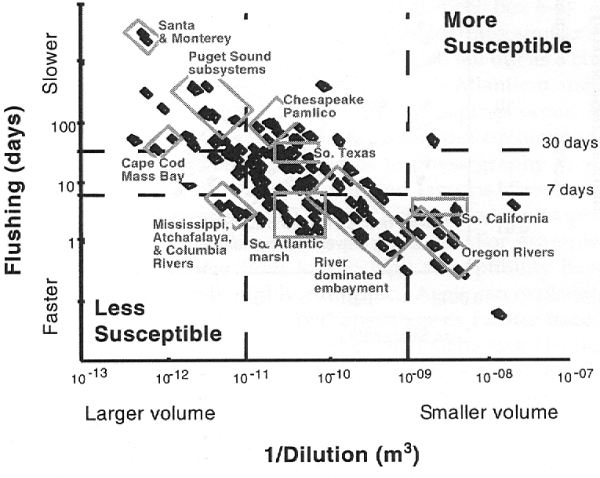


 |  |  | 17.2 Cultural eutrophication |
An important concept for cultural eutrophication is the residence time of nutrients in the recipient. Low water exchange results in high residence times and that increases the effect of the supplied nutrients and vice versa. The volume of the recipient influences its flushing time that determines the nutrient residence time (Figure 3). In addition the supply rate by discharge from the drainage basin influences the degree of eutrophication. In concert these factor can give rise to a large range of eutrophication scenarios, both on an annual and seasonal scale. High residence times will be encountered in land locked ecosystems such as fjords with high sills, the Baltic Sea and the Black Sea, while shallow regions or enclosed regions with lower threshold such as the northern Adriatic, the North Sea, Kattegat and many Norwegian fjords take an intermediate position. The degree of eutrophication is determined by the supply rate of nutrients. If the supply is high, such as the Kattegat, Baltic Sea, southern North Sea and certain estuaries and fjords, the combination of highs supply and increased residence times create a scenario for extensive cultural eutrophication.

If the organic matter supply is greater than the degradation and oxygen reserves or its hydrodynamic supply seasonal or long-term hypoxia or anoxia will develop. This phenomenon has been encountered in increasing frequency and has been often been interpreted as a sign of eutrophication although changes in vertical mixing and stratification also can cause hypoxia or anoxia. Further, an increasing Harmful algae bloom (HAB) frequency have been interpreted as a consequence of eutrophication (Figure 4). In the Seto Inland Sea, one of the most important aquaculture regions in Japan, a large-scale increase in HABs was encountered from the 60ties and onwards. Increasing control of the effluents in the region in the 80ties and onwards ahs result in a sharp decrease in HAB. However, it is not easy to indicate with confidence if the increased frequency of HAB all over the world is accelerated by eutrophication. For this we have too few reports from the days prior to aquaculture and to few long time series of phytoplankton. HAB have been observed throughout the times: The first HAB report can be found in the Old Testament (Exodus 7: 20-21). "...and all the waters that were in the river were turned to blood. And the fish that was in the river died; and the river stank, and the Egyptians could not drink the water of the river ...". On the background of the extensive changes in ecosystem structure and composition increased HAB frequencies seem most likely.

Advent of opportunists and introduced species in eutrophicated regions is well known. For example, 3/4 of the benthic biomass of the Rhine River is comprised by inadvertently introduced species. There is great concern worldwide what happens to lacustrin and marine ecosystems under the impact of introduced and alien species. The number of alien species, often introduced by ballast waters, transport of aquaculture organisms, channels or voluntary introduction, is ever increasing. The long-term consequences are more or less unknown.
 |  |  | 17.2 Cultural eutrophication |